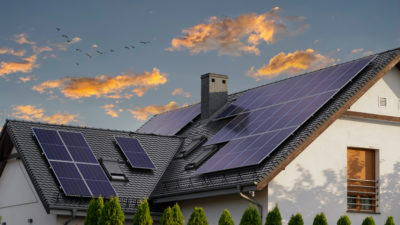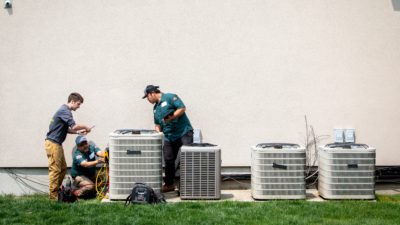Your refrigerator, dishwasher, clothes washer, and clothes dryer might use more energy than you think. Switching to an energy-efficient model can help you save energy and money year-round and there are rebates and no-cost incentives available to help with the cost. Whether you’re ready to upgrade or not, everyone can start using some of the tips below to use their appliances in a more energy-friendly way.
Refrigerator
Even if your fridge seems to be hanging on and cools well enough, an outdated refrigerator can increase your energy costs by $100 every year, according to energystar.gov. ENERGY STAR-certified refrigerators are approximately 9% more energy efficient which means you can save money on something that is always powered on at home.
According to energystar.gov, newer more efficient models have compressors that create minimal heat and use less energy, improved insulation which means less energy is used to keep your items cool, and temperature technology that helps the appliance operate more efficiently every day.
When you use your current or new refrigerator, follow these tips to save energy and money:
- Set the temperature between 35-38 degrees F
- Position your refrigerator away from heat sources like an oven, dishwasher, or direct sunlight
- Leave space between the wall and the fridge (a few inches) to allow for proper air circulation
- Keep condenser coils clean if you have an older refrigerator
- Don’t leave the refrigerator door open for too long
- Replace door seals on your older model if they aren’t airtight
If you decide to upgrade to a more energy-efficient model, the sponsors of the Mass Save® program offer a $75 rebate plus no-cost pickup and removal of your old appliance. Did you know that 95% of a refrigerator can be recycled? It’s a green choice to ensure your old fridge is responsibly recycled. Go here to learn more about scheduling a pickup.
Dishwasher
An energy-efficient dishwasher typically uses 4-6 gallons per load with most of the energy used for heating water, according to the sponsors of the Mass Save program.
According to energystar.gov, a standard ENERGY STAR-certified dishwasher costs approximately $35 per year to use and can save you almost 4,000 gallons of water over its lifetime. New energy-efficient technology includes soil sensors to detect how dirty your dishes are so that your dishwasher can cut back on water use and wash time if possible. Newer models also include innovations like improved water filtration, energy-efficient jets, and dish rack designs that decrease energy and water use and optimize performance.
To make your dishwasher run more efficiently:
- Only run a full load of dishes instead of half or small loads
- Don’t pre-rinse, just scrape off food (pre-rinsing can use up to 20 gallons of water according to Consumer Reports)
- Air dry dishes by skipping the dry cycle and cracking the dishwasher door to let air flow
If you’re looking for other ways to save water, check out our blog for more tips here. As a Mass Save partner, we offer no-cost energy-efficient showerheads and faucet aerators to eligible Massachusetts residents through a Home Energy Assessment. It’s all no-cost and no obligation! Sign up here to get access to no-cost water-saving items.
Clothes Washer
Did you know that the typical family in the U.S. washes approximately 300 loads of laundry every year? That’s a lot of energy use! When you upgrade to a more energy-efficient clothes washer, it adds up to 25% less energy and 33% less water than your older model.
According to Consumer Reports, you can save more than $100 per year with an energy-efficient clothes washer, compared to an outdated clothes washer that you might use now.
According to energystar.gov, technological advances of an energy-efficient washer include:
- It rinses clothes with high-pressure spraying instead of soaking clothes in a full tub of water
- A front load washer takes clothes through a small amount of water instead of rubbing clothes against an agitator in a full tub
- A top load washer flips and spins clothes through a decreased stream of water
- The motor spins clothes 2-3 times faster during the spin cycle to release more water from the clothes which equals less energy used by the dryer
- It uses about 14 gallons of water compared to the 20+ that a standard machine uses
To use your washer most effectively, follow these tips:
- Use high efficiency detergent to ensure it runs its best (if you have a new high efficiency washer)
- Run full loads whenever possible because it uses the same energy to run a small load
- Wash in cold water (water heating is 90% of its energy use) when possible
- Switch your water temp from hot to warm to cut energy use by 50%
- Choose a high spin speed or extended spin option to cut back on drying time
According to energystar.gov, an energy-efficient washer can even save you enough (or almost enough) to pay for a new dryer! You can also get a rebate of $150 from the sponsors of the Mass Save program to put toward the cost. Find out more here.
Clothes Dryer
According to energystar.gov, approximately 80% of homes in the U.S. have a clothes dryer. If all dryers sold in the U.S. were energy-efficient, U.S. households could save $1.5 billion every year in energy costs and prevent greenhouse gas emissions equal to 2 million+ vehicles on the road.
The American Council for an Energy-Efficient Economy notes that a typical outdated clothes dryer uses approximately 2-4 times more energy than a new clothes washer and twice as much energy as an energy-efficient refrigerator.
With all that energy, it’s surprising that the first ENERGY STAR-certified dryers didn’t even show up in stores until 2014. The good news is that they now use 20% less energy than conventional dryers and include advanced technology like automatic termination settings with moisture sensors to shut off the dryer when your clothes are dry!
While there are many types of energy-efficient dryer options, heat pump dryers are the most energy efficient and are said to use up to 60% less energy than conventional models. A heat pump dryer works by taking heat from a room’s indoor air and using it to heat the air inside the dryer for your clothes. A conventional electric dryer relies on a heating element. There are also dryers that use both technologies and have developed into a hybrid version.
Here are some energy saving tips when you dry your clothes:
- Dry an appropriate load so that there’s enough air circulating over your freely tumbling clothes (not too small or too large)
- Dry on a low heat setting for a longer cycle to use less energy
- Clean the lint filter after every load to improve air circulation, increase safety, and optimize efficiency
- Scrub the lint filter once a month if you use dryer sheets so the motor performs its best
- Use the cool down cycle to allow clothes to finish drying with the remaining heat left in the dryer
- Wash and dry multiple loads in a row to utilize the heat leftover from the previous load to dry the next load
When we think about our weekly habits, our refrigerator, dishwasher, clothes washer, and dryer impact our energy use and our wallet. Upgrading an appliance will not only save energy and money, but it will pay for itself with the savings that pile up year after year.
What about your heating and cooling equipment? If you’re ready to use some rebates to upgrade, we have you covered at HomeWorks Energy. Give our home energy specialists a call at (781) 305-3319 or click here to schedule a no-cost Heating and Cooling Consultation. We will show you how to access eligible rebates and incentives and help you start saving year-round!








